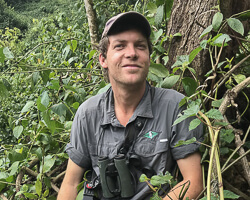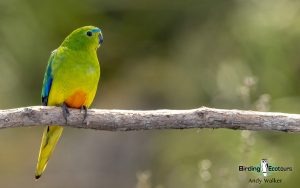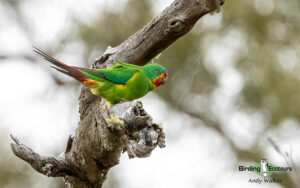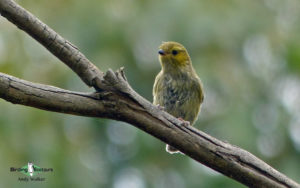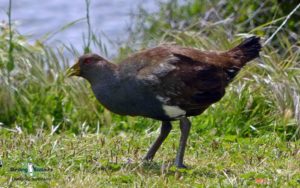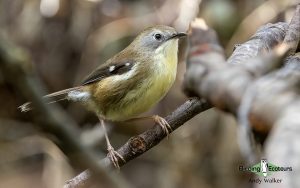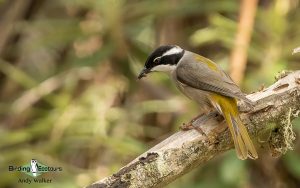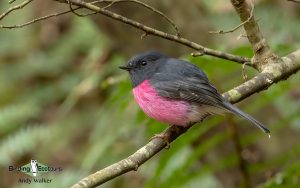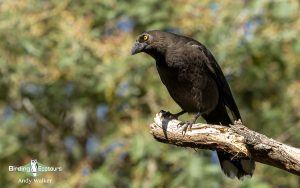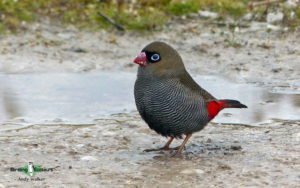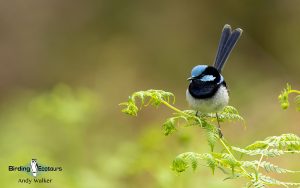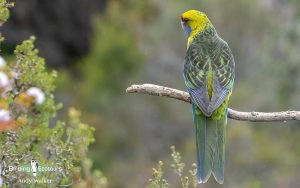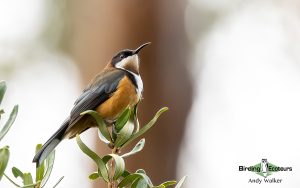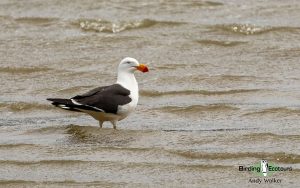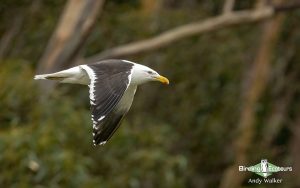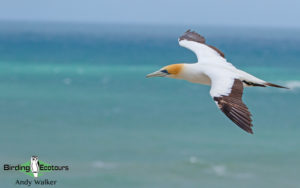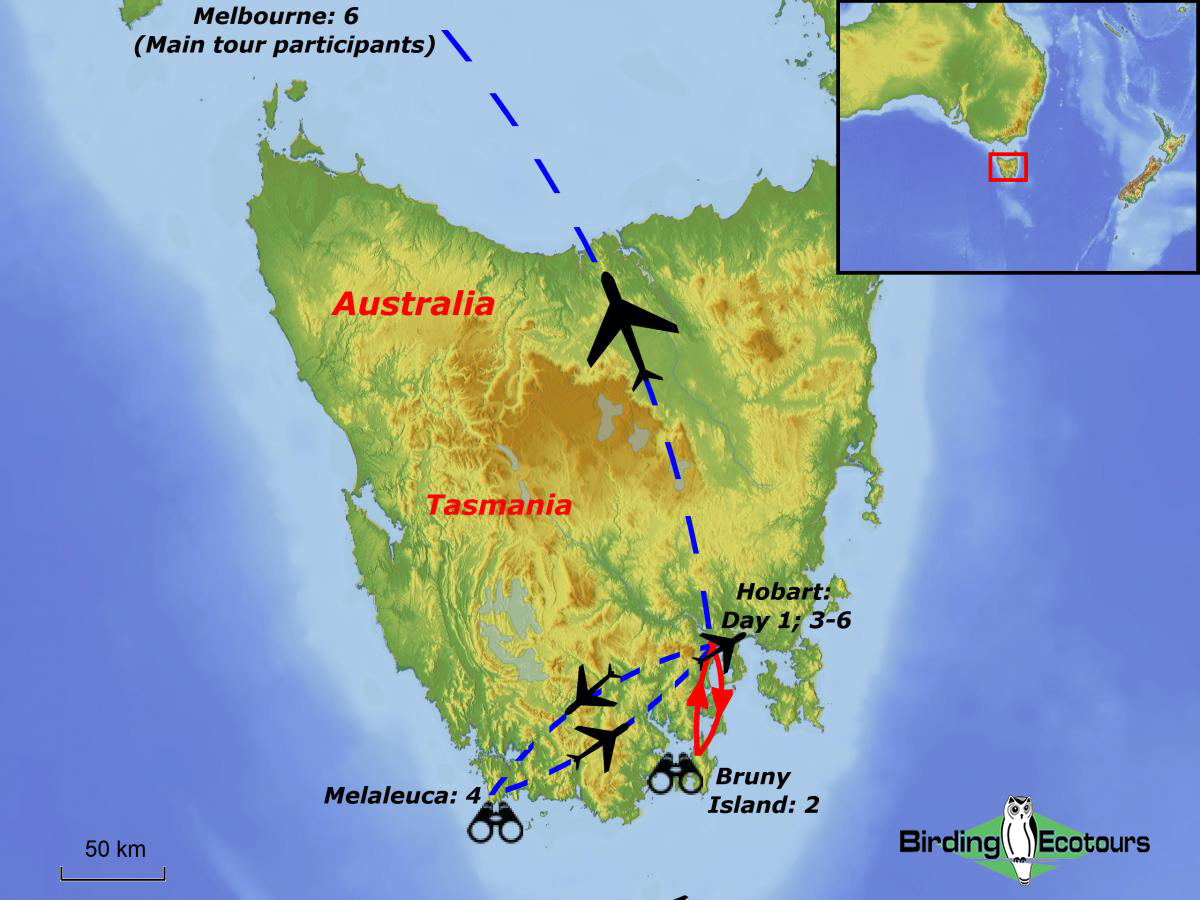Birding Tour Australia: Tasmania – Endemics and the Orange-bellied Parrot
Go to: Australia Birding Tours | Birding Tours in Australasia | All our birding tours
Australia: Tasmania – Endemics and the Orange-bellied Parrot
October 2025/2026/2027
This small group tour of the Australian island state of Tasmania looks for all Tasmanian endemics (we usually see them all well) and also includes a day-trip flight to look for the Critically Endangered (BirdLife International) Orange-bellied Parrot, not everyone offers this option within their tours so do check as this is the only realistic way to see this species.
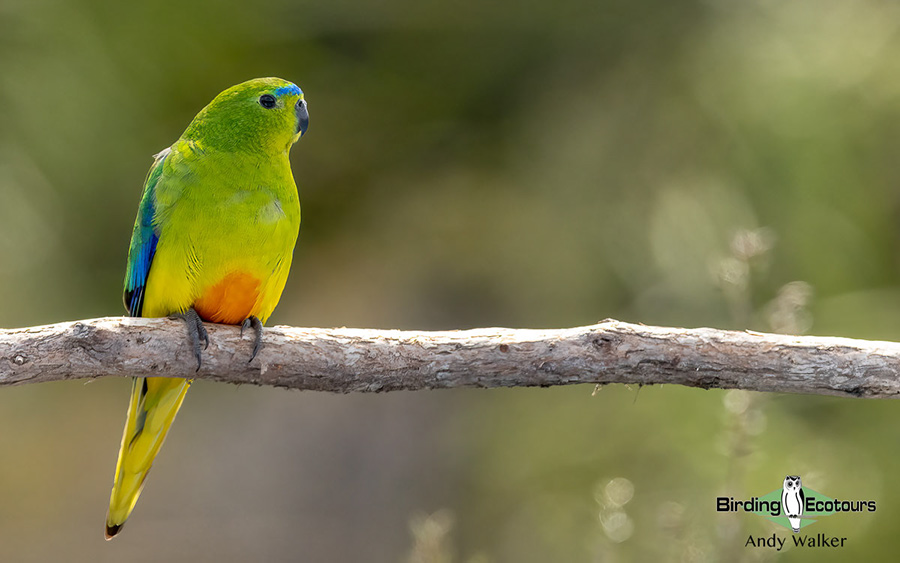 The handsome Orange-bellied Parrot is the primary target on this tour.
The handsome Orange-bellied Parrot is the primary target on this tour.
Adjoined to the mainland until the end of the last glacial period about ten thousand years ago, Tasmania is both geographically and genetically isolated from the Australian mainland. Through the millennia this island has developed its own unique set of plants and animals, including twelve avian endemics: Forty-spotted Pardalote, Tasmanian Nativehen, Green Rosella, Yellow Wattlebird, Scrubtit, Tasmanian Scrubwren, Tasmanian Thornbill, Dusky Robin, Yellow-throated Honeyeater, Black-headed Honeyeater, Strong-billed Honeyeater, and Black Currawong. Beyond the endemics Tasmania also harbors several species which winter on the mainland and breed on Tasmania, such as Orange-bellied Parrot already mentioned above, Swift Parrot another Critically Endangered (BirdLife International) parrot and another major target on this tour, and Tasmanian Boobook (some of which seem to overwinter in Victoria).
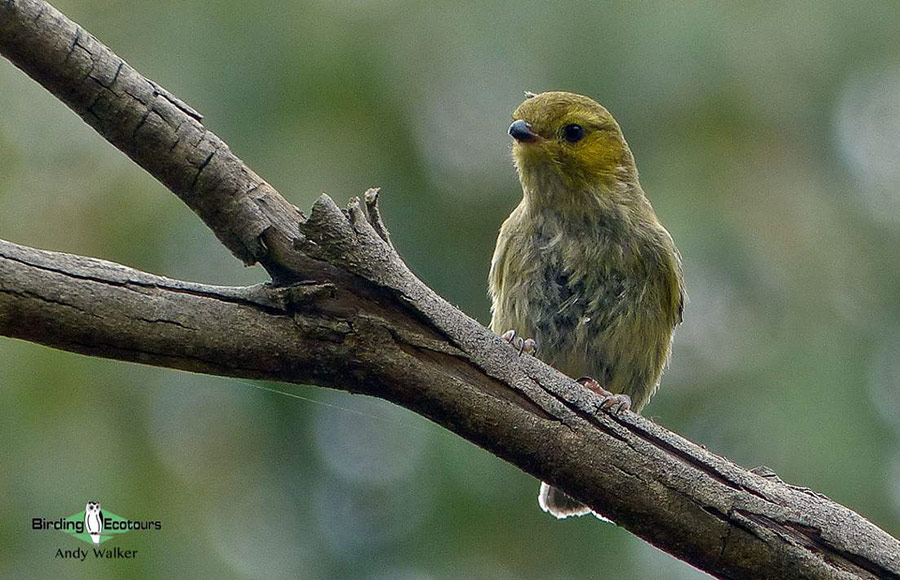
This tour also offers wonderful opportunities for many other highly sought-after species such as Little Penguin, Hooded Plover, Freckled Duck, Wedge-tailed Eagle, Grey Goshawk, (Eastern) Ground Parrot, Yellow-tailed Black Cockatoo, Pink Robin, Flame Robin, Scarlet Robin, Olive Whistler, Southern Emu-wren, and Beautiful Firetail.
For those wishing to continue exploring Australia, this tour can be combined with our Australia Birding Tour: Eastern Australia – from the Outback to the Wet Tropics tour.
Itinerary (6 days/5 nights)
Day 1. Arrival in Hobart
Afternoon arrival at Hobart International Airport and transfer to your hotel in the city, our base for the next few nights, with the rest of the day at your leisure.
Overnight: Hobart
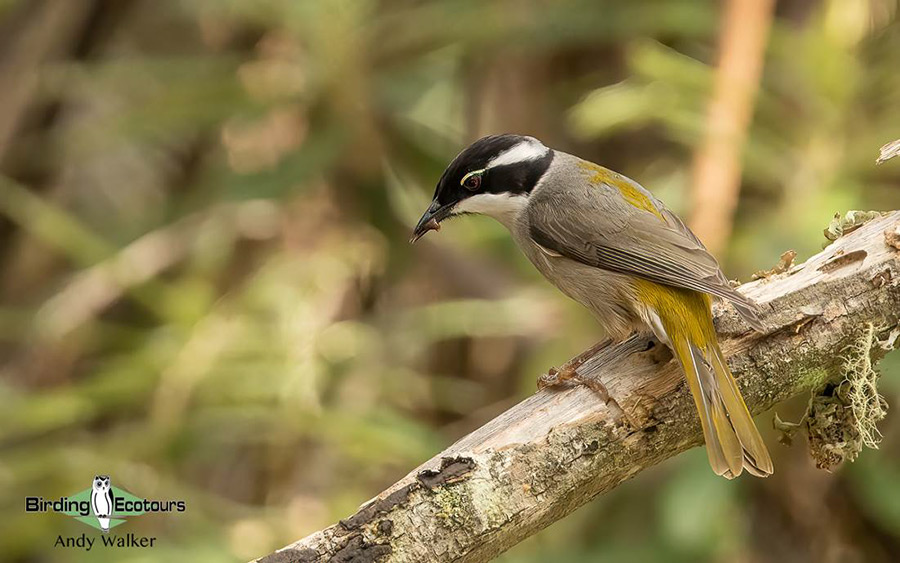
Day 2. Hobart environs
We spend the day birding at a couple of sites within close proximity to Hobart city, exploring the beautiful Fern Glade at Mt Wellington and the nearby Waterworks Reserve, where we can expect to get our list of Tasmanian endemic species up and running with Tasmanian Scrubwren, Scrubtit, Tasmanian Thornbill, Black Currawong, Yellow Wattlebird, Dusky Robin, and Strong-billed Honeyeater. The supporting cast may include Pink Robin, Bassian Thrush, and Olive Whistler.
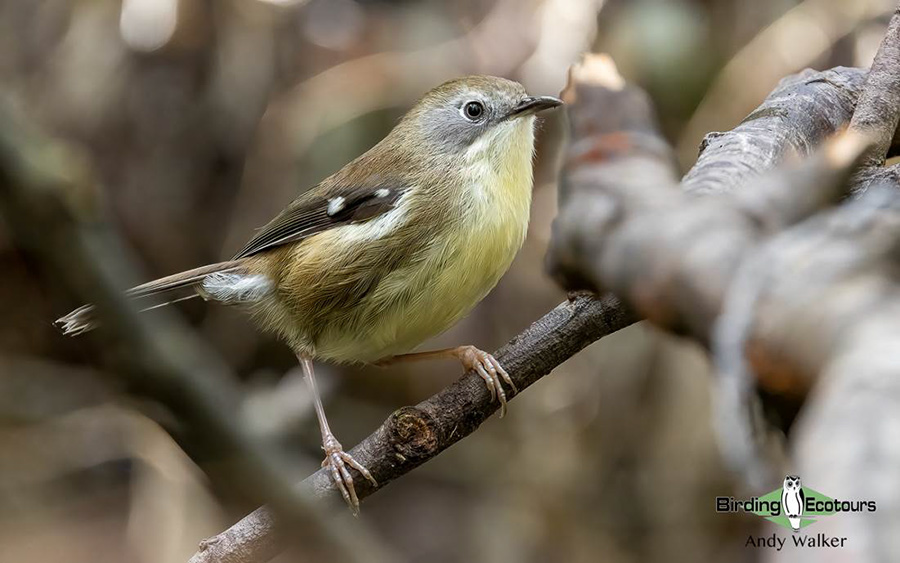
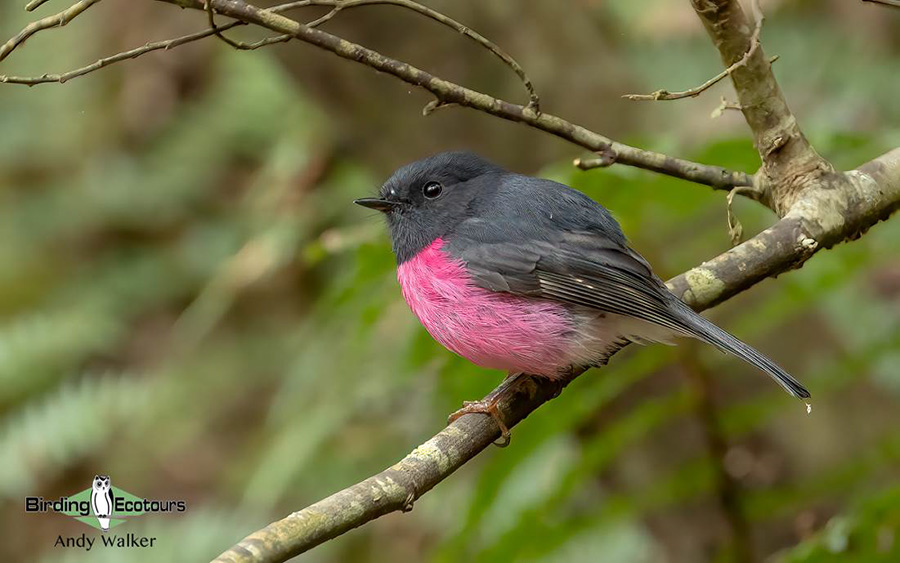
Day 3. Melaleuca Orange-bellied Parrot day trip
An unforgettable day is in store for us today! Weather-permitting we will board a small plane early in the morning, flying over some incredible scenery over southwestern Tasmania before descending onto the remote airstrip at Melaleuca. Originally a tin mine, Melaleuca is now the center of conservation efforts aimed at restoring the wild population of the Critically Endangered (BirdLife International) Orange-bellied Parrot. A Tasmanian breeding endemic, these beautiful little parrots are in a dire situation, with fewer than forty individuals left in the wild. Time unfortunately seems to be running out for them.
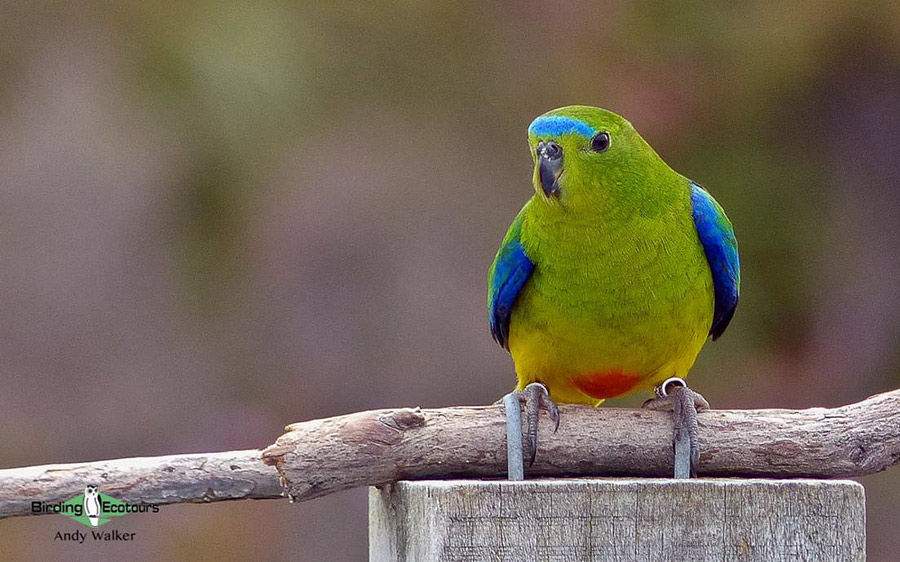
The surrounding heath hosts a healthy population of Southern Emu-wren, Striated Fieldwren, Olive Whistler, Pink Robin, Crescent Honeyeater, Beautiful Firetail, and the very secretive and subtly beautiful (Eastern) Ground Parrot, which we will also try to find. Over the course of the day we will be truly spoiled with a range of fantastic local Tasmanian food and drink. Our return flight to Hobart late in the afternoon will likely take us on a different route back to Hobart, offering more views of stunning mountain scenery. This is often considered one of the most enjoyable days across all of our Australian tours.
Overnight: Hobart
Day 4. Hobart to Bruny Island
Located off the southeastern coast of Tasmania, Bruny Island supports all twelve currently recognized Tasmanian endemics, including the world’s largest population of the Endangered (BirdLife International) Forty-spotted Pardalote. We will board a ferry to this rich site during the morning, watching for White-bellied Sea Eagle, Pacific Gull, and Black-faced Cormorant on our way out.
Once we arrive on the island, we will spend the better part of the day looking for all the Tasmanian endemics, such as the demure Dusky Robin, the vociferous Yellow Wattlebird, and the comical Tasmanian Nativehen. By scanning sandy beaches, we also hope to connect with the increasingly rare Hooded Plover. While here we will also look for the Critically Endangered (BirdLife International) breeding-endemic Swift Parrot, another species in a state of unfortunate rapid decline.
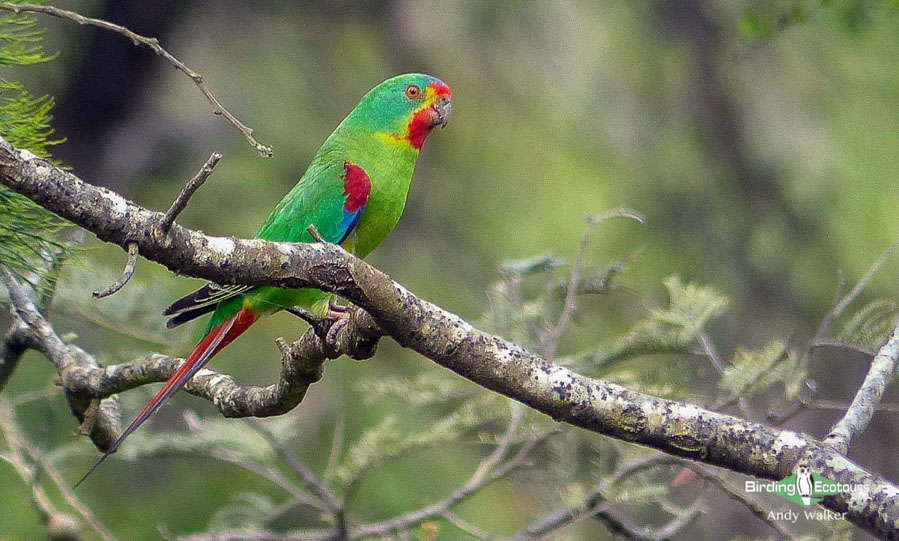
We will take a drive and walk around at dusk to look for Little Penguin and Short-tailed Shearwater as well as the recently split Tasmanian Boobook (a hawk-owl).
Overnight: Bruny Island
Day 5. Bruny Island to Hobart
We spend a full day birding Bruny Island, focusing perhaps on the scarcer endemics such as Scrubtit and Strong-billed Honeyeater. Other specialties like Wedge-tailed Eagle, Beautiful Firetail, Olive Whistler, (Eastern) Ground Parrot, and Swift Parrot will be among our targets too. We will also keep an eye open over the water for Black-browed Albatross and Shy Albatross, Australasian Gannet, and White-bellied Sea Eagle. In the late afternoon we will catch the ferry off Bruny Island and head back to our hotel in the city of Hobart.
Overnight: Hobart
Day 6. Birding Southeast Tasmania and tour concludes
We will have a final morning session birding at some sites in the southeast of the island, where we may find Latham’s Snipe, Baillon’s, Australian, and Spotless Crakes, Little Grassbird, and Australian Reed Warbler, as well as, hopefully, an assortment of waterbirds (depending on water levels).
The tour will end after a final lunch together before we make our way back to Hobart International Airport, where the tour ends at 2pm. Those continuing on the Birding Tour Australia: Eastern Australia – from the Outback to the Wet Tropics tour will fly to Melbourne for the start of that tour the following day.
Overnight: Not included
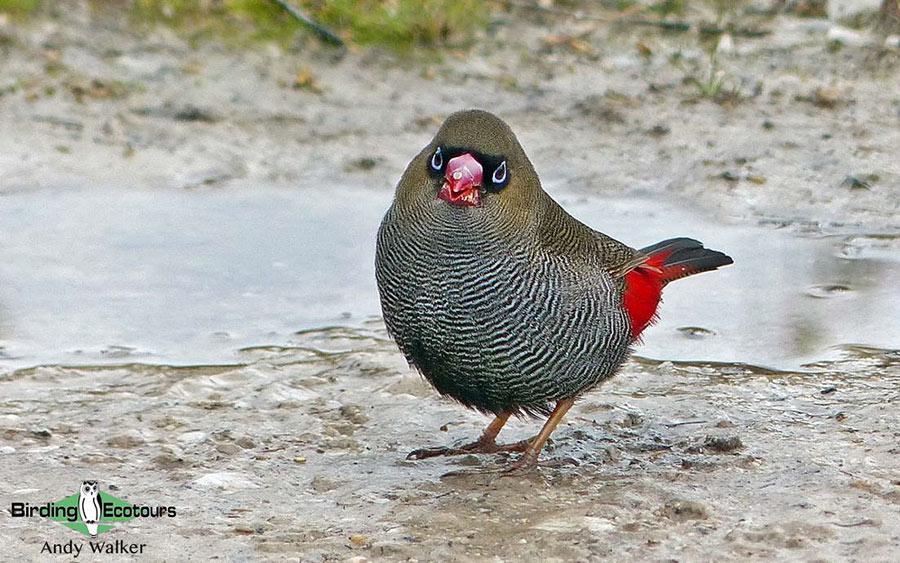
Please note that the itinerary cannot be guaranteed as it is only a rough guide and can be changed (usually slightly) due to factors such as availability of accommodation, updated information on the state of accommodation, roads, or birding sites, the discretion of the guides and other factors. In addition, we sometimes have to use a different international guide from the one advertised due to tour scheduling.
Download ItineraryTasmania Trip Report, October 2024
24 – 29 OCTOBER 2024
By Chris Lotz
DOWNLOAD TRIP REPORT
Overview
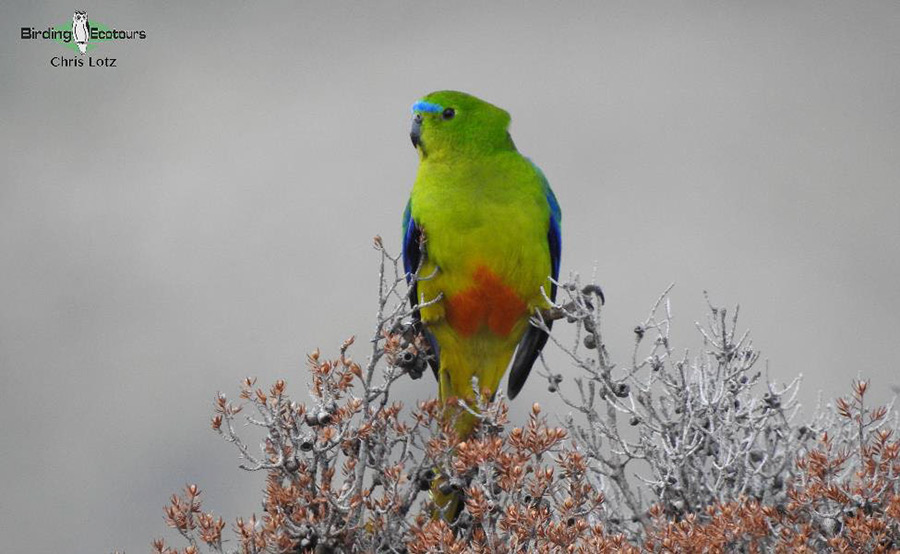
Orange-bellied Parrot showed well at Melaleuca.
Tasmania is a stunningly beautiful island, and we thoroughly enjoyed spectacular views during our scenic charter flight to remote Melaleuca (we include this for Orange-bellied Parrot), as well as fabulous views and idyllic surroundings on the wildlife paradise that is Bruny Island.
Detailed Report
Day 1, 24th October 2024. Arrival in Hobart
Everyone arrived today and the tour officially started with a 6 pm welcome dinner.
Day 2, 25th October 2024. Orange-bellied Parrots at Melaleuca
Today we took a wonderfully scenic charter flight to Melaleuca in the remote and beautiful southwestern corner of Tasmania. We enjoyed stunning scenery over Bruny Island and the south coast of Tasmania, as we hugged the coast en route to Melaleuca. On our return flight at the end of the day, we took a different (inland) route back to Hobart, enjoying gorgeous views of snow-capped mountains.
The main target around Melaleuca was the Critically Endangered (BirdLife International) Orange-bellied Parrot. This is the only site on the planet where this species breeds, and there are thought to be fewer than 30 adults left, and an outbreak of Psittacine Beak and Feather Disease in 2014 didn’t help the dire status of this species. We saw almost a third of the world population of these beautiful little parrots today. Here at Melaleuca, we also enjoyed seeing many Green Rosellas, a Tasmanian endemic, and we heard (Eastern) Ground Parrot. Yellow-throated Honeyeaters (also endemic), Southern Emu-wren, several close-up Striated Fieldwrens, a gorgeous Beautiful Firetail, and a couple of demure (but endemic!) Dusky Robins were all very popular birds with our group.
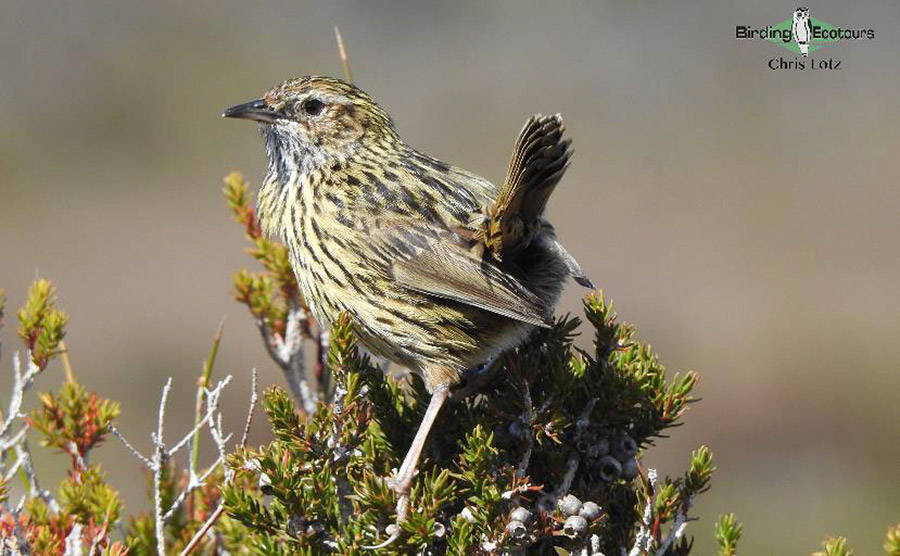
Striated Fieldwren showed nicely.
Out on the lagoon were Black Swans, a Little Black Cormorant and a couple of Little Pied Cormorants. These are common Australian birds, but all were new species for the tour participants.
After our charter flight touched down back in Hobart this afternoon, we continued looking around for birds. Notably, we increased our parrot count for the day up to eight species. These came in a wide variety of forms: attractive Eastern Rosellas, close up Musk Lorikeets showing really well feeding on Eucalyptus nectar (along with Noisy Miners), wonderfully pink Galahs, a Sulphur-crested Cockatoo,and a Little Corella. There were also many other great birds around Hobart. These included stacks of Tasmanian Nativehens, many of them with young chicks. (This is an entertaining, flightless Tasmanian endemic.) We also found some Maned and Pacific Black Ducks and a Hoary-headed Grebe. A Swamp Harrier flew over. There were stacks of Masked Lapwings, Kelp Gulls and Silver Gulls around. Australian Magpies, Grey Currawongs and Forest Ravens also put in appearances.
We also enjoyed seeing a great mammal, Southern Brown Bandicoot, during our late afternoon Hobart session.
All in all, this was a brilliant first full day on the picturesque island of Tasmania!
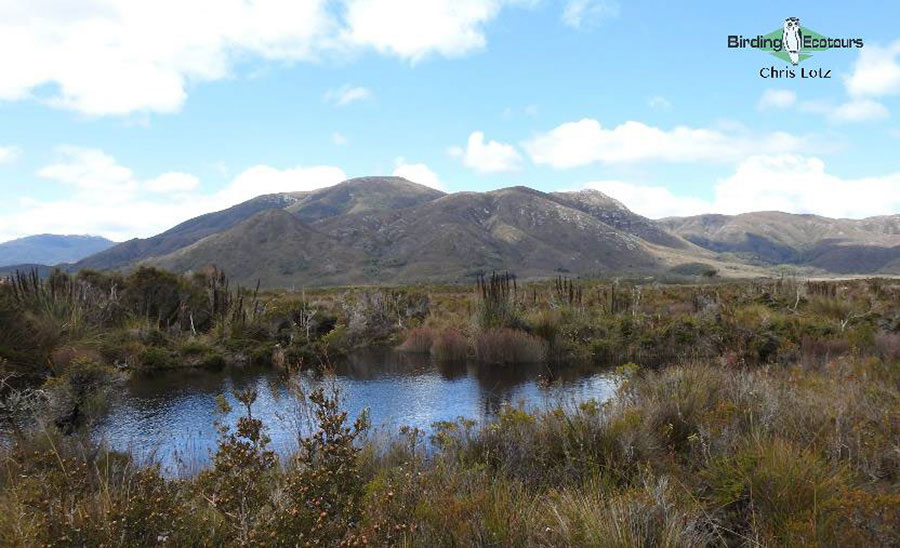
Melaleuca scenery.
Day 3, 26th October 2024. Birding Mount Nelson, Fern Glade, the Waterworks Reserve and Pipe Clay Lagoon
After breakfast, we headed to Mount Nelson to try and find Critically Endangered Swift Parrots and we were not disappointed! We enjoyed seeing about a dozen of these rare Tasmanian breeding endemics mingling with other parrots. Swift Parrots are declining rapidly due to nest predation by introduced Sugar Gliders.
We found a lot of other great birds around Mount Nelson. We found our first of many Superb Fairywrens (these are dazzling, confiding birds that have to be seen to be believed). We also saw several new honeyeaters in the form of Eastern Spinebill, New Holland Honeyeater, Little Wattlebird, the Tasmanian endemic giant honeyeater species Yellow Wattlebird, and a few of another endemic honeyeater, Black-headed Honeyeater.
There were many Striated Pardalotes around, as well as some Brown Thornbills, a Black-faced Cuckooshrike, Grey Currawongs, and huge-billed Tasmanian endemic Black Currawongs. A beautiful male Scarlet Robin was one of the highlights in this area.
Our next birding site for the morning was Fern Glade, on the forested slope of Mount Wellington. Here, we enjoyed great views of a Shining Bronze Cuckoo on the edge of the forest from the parking lot. As we started walking the forest trail, we found good numbers of Tasmanian Scrubwrens and Tasmanian Thornbills, both endemics. Another Tasmanian endemic, Scrubtit, proved far trickier but we eventually got superb views of one. Olive Whistlers and a female Pink Robin were also good to see.
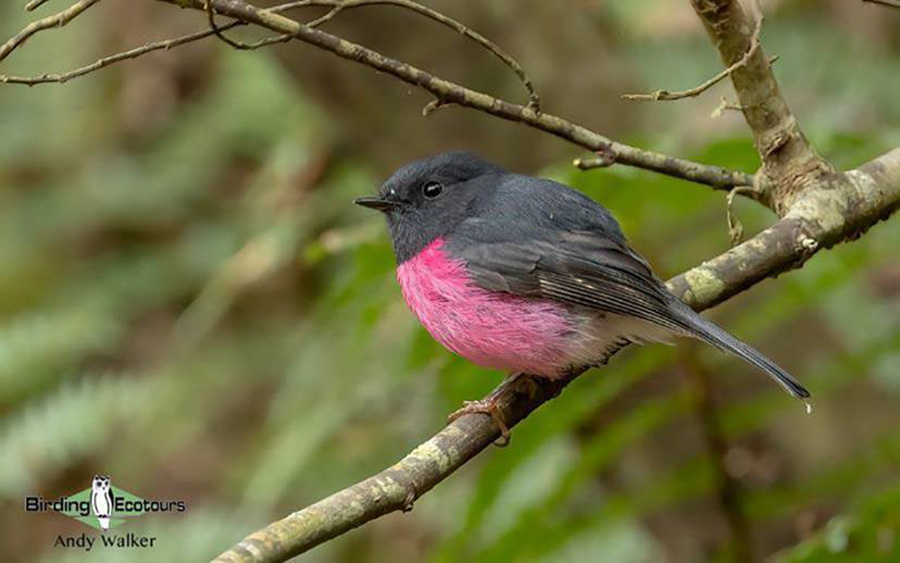
We had to wait until later in the tour to see a male Pink Robin, but we were too busy admiring it to photograph it, so this is Andy Walker’s photo from a previous year’s tour
After a delicious lunch at a nearby pub, we headed for the famous (among birders) Waterworks Reserve. There were several duck species here, including Hardhead which was new for the tour. A Laughing Kookaburra and a Brown Goshawk put in brief appearances. During the relatively warm hours of the day, the reserve was unusually quiet, so we decided to move to an area with coastal lagoons near Cremorne.
The Cremorne/Pipe Clay Lagoon area proved very productive. We found some new waterfowl species in the form of beautiful Australian Shelducks, a very co-operative male Musk Duck (such a bizarre species!) and a Chestnut Teal. Black-faced Cormorants showed well, as did massive-billed Pacific Gulls. A White-bellied Sea Eagle, a couple of Swamp Harriers, and a brief Brown Falcon were welcome additions to our raptor list. We enjoyed seeing some new shorebirds for the trip: four Bar-tailed Godwits, two Red-necked Stints, about a dozen Red-capped Plovers, large numbers of Pied Oystercatchers, and two Sooty Oystercatchers.
An Australian Pipit and a White-fronted Chat showed distantly.
All in all, this was another super-amazing day, but spectacular Bruny Island was calling our names, the next exciting stint on our agenda.
Day 4, 27th October 2024. Bruny Island
We caught the 7.10 am ferry onto Bruny Island and immediately headed to our Forty-spotted Pardalote site, finding a couple of them after exercising a bit of patience. This is an Endangered (BirdLife International) species with a tiny range, occurring in only three small parts of Tasmania. The supporting cast here included a few beautiful Blue-winged Parrots, a couple of Pallid Cuckoos, several close-up Yellow-rumped Thornbills and a large number of New Holland and Black-headed Honeyeaters.
Continuing further onto Bruny Island, we briefly saw a majestic pair of humongous Wedge-tailed Eagles soaring. Soon afterwards, we got more prolonged views of a White-bellied Sea Eagle.A Grey Butcherbird and a Laughing Kookaburra were next on the birding menu.
Two Tree Point was rewarding, with a Hooded Plover (Dotterel),showing really well, some Pacific Gulls with their massive bills dwarfing the nearby Silver Gulls, an Australasian Gannet that almost flew over us, a Shy Albatross majestically gliding low over the water in the distance, and a number of Strong-billed Honeyeaters, yet another Tasmanian endemic. Superb Fairywrens were everywhere, here and at virtually all other places we visited today. They are such confiding, showy, spectacular birds.
After a delicious lunch, we birded the Adventure Bay area, which proved great for some spectacular robins. We enjoyed close views of a pair of Scarlet Robins and two separate Flame Robins, one a luminously colorful male. We also got great views of Chestnut Teals and a number of other birds around this area.
On the way to our accommodation for the night, we located a Fan-tailed Cuckoo.We checked into our accommodation around 4 pm and heard a Tawny Frogmouth and saw a beautiful Australian Golden Whistler.
After a tasty dinner, we went to The Neck Rookery to observe huge numbers of Short-tailed Shearwaters coming in to roost. On our way there, we saw loads of Red-necked (Bennett’s) Wallabies, some carrying joeys in their pouches.Driving back to the accommodation after dark, we were pleased to see some great mammals. Rufous-bellied (Tasmanian) Pademelons, beautifully spotted Eastern Quolls and a Common Ringtail Possum were highlights.
Day 5, 28th October 2024. Another morning on Bruny Island, and an afternoon back on the “mainland”
The first bird we wanted to target was a male Pink Robin as, to date, we had only seen the female. After some searching, we eventually found one at Clennetts Top Mill Site, and got superb views.
We then went to the Cape Bruny lighthouse. The scenery here was gorgeous. It was, however, excessively windy, making birding challenging. We did see our first Short-beaked Echidna; the Tasmanian endemic subspecies is very different from the mainland form, and a bizarre animal.
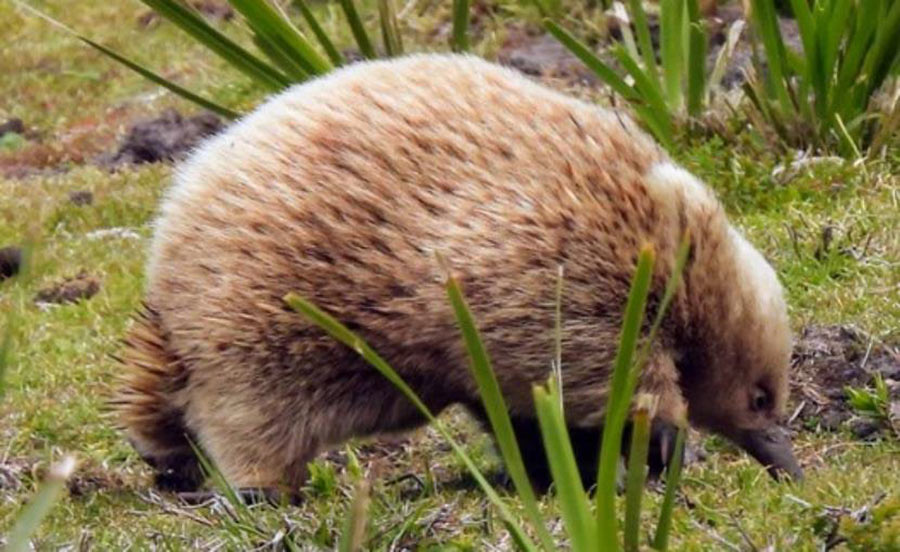
Short-beaked Echidna (photo by tour participant Elizabeth Bailey).
Despite the wind, we did enjoy seeing some other good birds from the lighthouse, including Peregrine Falcon, White-bellied Sea Eagle, Flame Robin, Scarlet Robin and countless New Holland Honeyeaters.
It was time to leave wonderful Bruny Island, but we made some birding stops en route to the ferry. We spent a little time birding around The Neck Campground, where we got good views of Olive Whistler and several other good birds we’d seen previously. At McCrackens Gully, we enjoyed an amazing view of a magnificent Wedge-tailed Eagle, several Australasian Grebes and various others. While waiting for the ferry, we got an excellent view of a White-bellied Sea Eagle, and some Black-faced Cormorants, amongst others. We checked into our Hobart hotel early enough for a bit of a rest before dinner.
Day 6, 29th October 2024. Final Tasmania birding
After breakfast, we headed to the Margate area to try and locate Crescent Honeyeater. After some patience, we eventually managed to get good views of one. We then headed to a nearby site where we added Spotted Pardalote to our list. We saw a lot of other bird species this morning, although the above two were the only new trip birds. We then headed to the airport to fly to Melbourne in preparation for our eastern Australia birding tour.
Bird List – Following IOC (version 14.2, August 2024)
Birds ‘heard only’ are marked with (H) after the common name, all other species were seen. The following notation after species names is used to show conservation status following BirdLife International: CR = Critically Endangered, EN = Endangered, VU = Vulnerable.
| Common name | Scientific name |
| Ducks, Geese, Swans (Anatidae) | |
| Black Swan | Cygnus atratus |
| Australian Shelduck | Tadorna tadornoides |
| Maned Duck | Chenonetta jubata |
| Pacific Black Duck | Anas superciliosa |
| Mallard | Anas platyrhynchos |
| Chestnut Teal | Anas castanea |
| Musk Duck | Biziura lobata |
| Frogmouths (Podargidae) | |
| Tawny Frogmouth (H) | Podargus strigoides |
| Cuckoos (Cuculidae) | |
| Shining Bronze Cuckoo | Chalcites lucidus |
| Pallid Cuckoo | Heteroscenes pallidus |
| Fan-tailed Cuckoo | Cacomantis flabelliformis |
| Pigeons, Doves (Columbidae) | |
| Rock Dove | Columba livia |
| Spotted Dove | Spilopelia chinensis |
| Rails, Crakes & Coots (Rallidae) | |
| Tasmanian Nativehen (Endemic) | Tribonyx mortierii |
| Eurasian Coot | Fulica atra |
| Grebes (Podicipedidae) | |
| Australasian Grebe | Tachybaptus novaehollandiae |
| Hoary-headed Grebe | Poliocephalus poliocephalus |
| Great Crested Grebe | Podiceps cristatus |
| Oystercatchers (Haematopodidae) | |
| Pied Oystercatcher | Haematopus longirostris |
| Sooty Oystercatcher | Haematopus fuliginosus |
| Plovers (Charadriidae) | |
| Hooded Plover – VU | Charadrius cucullatus |
| Masked Lapwing | Vanellus miles |
| Red-capped Plover | Anarhynchus ruficapillus |
| Sandpipers, Snipes (Scolopacidae) | |
| Bar-tailed Godwit | Limosa lapponica |
| Red-necked Stint | Calidris ruficollis |
| Gulls, Terns, Skimmers (Laridae) | |
| Silver Gull | Chroicocephalus novaehollandiae |
| Pacific Gull | Larus pacificus |
| Kelp Gull | Larus dominicanus |
| Albatrosses (Diomedeidae) | |
| Shy Albatross | Thalassarche cauta |
| Petrels, Shearwaters, Diving Petrels (Procellariidae) | |
| Short-tailed Shearwater | Ardenna tenuirostris |
| Gannets, Boobies (Sulidae) | |
| Australasian Gannet | Morus serrator |
| Cormorants, Shags (Phalacrocoracidae) | |
| Little Pied Cormorant | Microcarbo melanoleucos |
| Black-faced Cormorant | Phalacrocorax fuscescens |
| Little Black Cormorant | Phalacrocorax sulcirostris |
| Great Cormorant | Phalacrocorax carbo |
| Herons, Bitterns (Ardeidae) | |
| White-faced Heron | Egretta novaehollandiae |
| Kites, Hawks, Eagles (Accipitridae) | |
| Wedge-tailed Eagle | Aquila audax |
| Brown Goshawk | Tachyspiza fasciata |
| Collared Sparrowhawk | Tachyspiza cirrocephala |
| Swamp Harrier | Circus approximans |
| White-bellied Sea Eagle | Icthyophaga leucogaster |
| Kingfishers (Alcedinidae) | |
| Laughing Kookaburra | Dacelo novaeguineae |
| Caracaras, Falcons (Falconidae) | |
| Australian Hobby | Falco longipennis |
| Brown Falcon | Falco berigora |
| Peregrine Falcon | Falco peregrinus |
| Cockatoos (Cacatuidae) | |
| Galah | Eolophus roseicapilla |
| Little Corella | Cacatua sanguinea |
| Sulphur-crested Cockatoo | Cacatua galerita |
| Old World Parrots (Psittaculidae) | |
| Green Rosella (Endemic) | Platycercus caledonicus |
| Eastern Rosella | Platycercus eximius |
| Swift Parrot – CR | Lathamus discolor |
| Ground Parrot (H) | Pezoporus wallicus |
| Blue-winged Parrot – VU | Neophema chrysostoma |
| Orange-bellied Parrot – CR | Neophema chrysogaster |
| Musk Lorikeet | Glossopsitta concinna |
| Australasian Wrens (Maluridae) | |
| Superb Fairywren | Malurus cyaneus |
| Southern Emu-wren | Stipiturus malachurus |
| Honeyeaters (Meliphagidae) | |
| Eastern Spinebill | Acanthorhynchus tenuirostris |
| White-fronted Chat | Epthianura albifrons |
| Crescent Honeyeater | Phylidonyris pyrrhopterus |
| New Holland Honeyeater | Phylidonyris novaehollandiae |
| Yellow-throated Honeyeater (Endemic) | Nesoptilotis flavicollis |
| Strong-billed Honeyeater (Endemic) – VU | Melithreptus validirostris |
| Black-headed Honeyeater (Endemic) | Melithreptus affinis |
| Little Wattlebird | Anthochaera chrysoptera |
| Yellow Wattlebird (Endemic) | Anthochaera paradoxa |
| Noisy Miner | Manorina melanocephala |
| Pardalotes (Pardalotidae) | |
| Forty-spotted Pardalote (Endemic) – EN | Pardalotus quadragintus |
| Striated Pardalote | Pardalotus striatus |
| Australasian Warblers (Acanthizidae) | |
| Striated Fieldwren | Calamanthus fuliginosus |
| Tasmanian Scrubwren (Endemic) | Sericornis humilis |
| Scrubtit (Endemic) | Acanthornis magna |
| Yellow-rumped Thornbill | Acanthiza chrysorrhoa |
| Tasmanian Thornbill (Endemic) | Acanthiza ewingii |
| Brown Thornbill | Acanthiza pusilla |
| Woodswallows, Butcherbirds & Allies (Artamidae) | |
| Dusky Woodswallow | Artamus cyanopterus |
| Australian Magpie | Gymnorhina tibicen |
| Grey Butcherbird | Cracticus torquatus |
| Black Currawong (Endemic) | Strepera fuliginosa |
| Grey Currawong | Strepera versicolor |
| Cuckooshrikes (Campephagidae) | |
| Black-faced Cuckooshrike | Coracina novaehollandiae |
| Whistlers & Allies (Pachycephalidae) | |
| Olive Whistler | Pachycephala olivacea |
| Australian Golden Whistler | Pachycephala pectoralis |
| Grey Shrikethrush | Colluricincla harmonica |
| Fantails (Rhipiduridae) | |
| Willie Wagtail | Rhipidura leucophrys |
| Grey Fantail | Rhipidura albiscapa |
| Monarchs (Monarchidae) | |
| Magpie-lark | Grallina cyanoleuca |
| Satin Flycatcher | Myiagra cyanoleuca |
| Crows, Jays (Corvidae) | |
| Forest Raven | Corvus tasmanicus |
| Australasian Robins (Petroicidae) | |
| Pink Robin | Petroica rodinogaster |
| Flame Robin | Petroica phoenicea |
| Scarlet Robin | Petroica boodang |
| Dusky Robin (Endemic) – VU | Melanodryas vittata |
| Larks (Alaudidae) | |
| Eurasian Skylark | Alauda arvensis |
| Swallows, Martins (Hirundinidae) | |
| Welcome Swallow | Hirundo neoxena |
| Tree Martin | Petrochelidon nigricans |
| White-eyes (Zosteropidae) | |
| Silvereye | Zosterops lateralis |
| Starlings, Rhabdornises (Sturnidae) | |
| Common Starling | Sturnus vulgaris |
| Thrushes (Turdidae) | |
| Bassian Thrush | Zoothera lunulata |
| Common Blackbird | Turdus merula |
| Old World Sparrows, Snowfinches (Passeridae) | |
| House Sparrow | Passer domesticus |
| Waxbills, Munias & Allies (Estrildidae) | |
| Beautiful Firetail | Stagonopleura bella |
| Wagtails, Pipits (Motacillidae) | |
| Australian Pipit | Anthus australis |
| Finches, Euphonias (Fringillidae) | |
| European Goldfinch | Carduelis carduelis |
| Total seen | 102 |
| Total heard only | 2 |
| Total recorded | 104 |
Mammal List – Following Mammal Watching (April 2024)
| Common name | Scientific name |
| Echidnas (Tachyglossidae) | |
| Short-beaked Echidna | Tachyglossus aculeatus |
| Dasyures (Dasyuridae) | |
| Eastern Quoll – EN | Dasyurus viverrinus |
| Bandicoots (Peramelidae) | |
| Southern Brown Bandicoot | Isoodon obesulus |
| Kangaroos, Wallabies and Allies (Macropodidae) | |
| Rufous-bellied Pademelon (Endemic) | Thylogale billardierii |
| Red-necked Wallaby | Notamacropus rufogriseus |
| Ringtail Possums (Pseudocheiridae) | |
| Eastern Ring-tailed Possum | Pseudocheirus peregrinus |
| Hares and Rabbits (Leporidae) | |
| European Hare | Lepus europaeus |
| European Rabbit – EN | Oryctolagus cuniculus |
| Total | 8 |
DOWNLOAD TRIP REPORT
Please see the downloadable PDF above with the full species lists included. Please email us ([email protected]) for more trip reports from this destination.
Birding Tour Australia: Tasmania – Tasmanian Endemics and the Orange-Bellied Parrot
Tour-Specific Information
GENERAL INFORMATION ABOUT AUSTRALIA CAN BE READ HERE
TOUR OUTLINE
This short (just under one week in duration) Tasmanian birding tour offers an excellent chance of finding all of the Tasmanian resident endemic birds, as well as three Tasmanian breeding endemics (Swift Parrot, Orange-bellied Parrot, and Tasmanian Boobook) and a host of more widespread Australian endemics. The Tasmanian endemic bird targets on our birding tour of Tasmania include Tasmanian Nativehen, Green Rosella, Strong-billed Honeyeater, Black-headed Honeyeater, Yellow-throated Honeyeater, Yellow Wattlebird, Scrubtit, Tasmanian Scrubwren, Tasmanian Thornbill, Dusky Robin, Black Currawong, and Forty-spotted Pardalote. We can also find many other great Australian birds on this Tasmanian bird tour, such as Little Penguin, Hooded Plover, (Eastern) Ground Parrot, Southern Emu-wren, Flame Robin, Pink Robin, and Beautiful Firetail – some of Australia’s best birds in a short space of time. The tour starts and ends in, and is mainly based in Hobart.
This tour combines very well with our Birding Tour Australia: from the Outback to the Wet Tropics tour that covers the eastern side of Australia, including birding in Victoria, New South Wales, and north and south Queensland.
DAILY ACTIVITIES, PHYSICAL REQUIREMENTS, AND TOUR PACE
This is a fairly relaxed pace Tasmania birding tour, with limited driving and few accommodation changes. Accommodation and food are generally considered to be of a higher standard than most other bird tours, given the areas we are staying in and visiting have been developed for tourism. Tasmania is an island in the far southeast of Australia and is often wetter and colder than other parts of the vast country. The longest drive of the tour is likely to be two hours (between Hobart and our accommodation on South Bruny Island); however, in reality, we will be birding our way there, so it will take longer to reach.
We will be based in Hobart for most of the tour, and we will make morning and afternoon trips out of the city to key birding sites in our quest to find the endemic birds of Tasmania (e.g., drives of around 20 – 30 minutes). On one full day, we will take a charter flight to the far southwest of the island (to Melaleuca) in pursuit of the Critically Endangered Orange-bellied Parrot (see the “Orange-bellied Parrot Trip” section below for more information). We will also spend one night and the majority of two days birding on the delightful Bruny Island. This small offshore island (reached by a short car ferry ride) acts as a refuge for many of Tasmania’s endemic birds, and we are sure to enjoy our time here during our Tasmanian bird tour.
Most of the walking on our Tasmania bird tour is considered easy, although there are two moderately strenuous walks. We will bird at a waterworks site near Hobart that has some loop circuits; these are slightly undulating, and we will probably walk about 1.2 – 1.8 miles (2 – 3 kilometers/km) on these, with a fair bit of stopping and scanning some reservoirs. A mountain trail near the city will be the most strenuous hike on the tour. This is probably a similar length to the aforementioned hike, but this is a windy uphill then downhill trail, which is steep in places. A hiking pole will be useful or necessary if you are unstable when walking. We will be looking for secretive forest birds here and going slowly. While on Bruny Island and in the southwest of Tasmania (Melaleuca), we will likely have a couple of hikes of around 3.5 – 5 miles (6 – 8 km), but these will be on mainly flat ground. All walking will be at a slow birding pace.
During our time on Bruny Island, we will take a look at dusk for Little Penguin and Tasmanian Boobook and may find some mammals at this time too.
TRANSPORTATION
We will use a 12-seater minibus on this Tasmanian bird tour. There will be limited baggage space in the vehicle, so please pack as lightly as possible for the tour (including within the seating area). It will be possible to leave larger baggage at our hotel in Hobart for our overnight trip to Bruny Island, which will help with space. There will not be masses of time spent in vehicles on this tour, the most vehicle time will be when we are travelling to and birding around Bruny Island.
We will take a short (approximately 30 minutes) car ferry ride between the Tasmanian “mainland” and Bruny Island. This crossing is usually smooth and stable, but if you suffer from motion sickness, you might want to bring along suitable medication.
The tour doesn’t include any domestic flights; however, we do take one chartered flight during the tour; see the “Orange-bellied Parrot Trip” section below for more information.
ORANGE-BELLIED PARROT TRIP
We will spend a full day of the tour taking a scenic flight into the remote wilderness in the Melaleuca area of southwest Tasmania. Our flight will leave Hobart at 08:30 hrs. and return there at 16:30 hrs. The flight time for each journey is approximately one hour. Our route out to Melaleuca is usually different from our route back to Hobart, thus maximizing the opportunities for spectacular landscape views (maybe even some snow-capped peaks!). We will be making this journey with Par Avion (a division of Airlines of Tasmania Pty Ltd.), and a gourmet lunch of local Tasmanian food and drinks will be provided. The aim of our trip is to connect with the extremely rare and Critically Endangered Orange-bellied Parrot. This area remains the stronghold for the species, where they are supported by massive levels of predator management, nest site provisions, and supplementary feeding. The area is also good for several other species, and we will look for these too.
We will be using a small aircraft, likely with a capacity of nine passengers. Depending on the final size of the group, we may have the plane to ourselves. We will need to supply body weight information to the airline ahead of our flight (so expect an email in the lead-up to the tour asking for this information). A carry-on baggage allowance of 8.8 pounds (4 kilograms) is permitted per person on this trip. Everyone will need to bring a personal water supply with them for the day. The carriage of dangerous goods is prohibited as per Civil Aviation Safety Authority regulations (e.g., including, but not limited to, compressed gases, explosives, corrosives, etc. – see here for full details – in general, the usual things you cannot take on a plane).
All flights are subject to change due to weather or other operational requirements. In case of poor weather cancellation, flights will be transferred to an alternative day if possible. We will make every effort to make the flight happen; however, there is a chance the trip might be cancelled if weather conditions are not suitable and an alternative date does not work. These factors are beyond our control.
Par Avion has a range of aircraft in their lineup, but we usually use the Britten-Norman Islander light utility aircraft on our tours. For further details, photographs, and frequently asked questions about this trip, please see here.
LUGGAGE
Please pack as lightly as possible for this Tasmanian birdwatching tour. A medium, soft-sided, and robust duffle bag is likely to work best for packing in the tour vehicle. You will be expected to load and unload your own bags into and out of vehicles and to/from your rooms.
We recommend a daypack is used to keep items that you wish to use daily when in the vehicle or when birding in the field (such as binoculars, camera, notebook, field guide, personal supply of water, snacks, umbrella, rain jacket, extra layers of clothing, etc.).
ACCOMMODATION
In Hobart, we stay at a city hotel, usually the Best Western Hobart, or equivalent. This hotel is typical of most modern city hotels, with air conditioning, ensuite bathrooms, and free Wi-Fi. The hotel has a restaurant where we will have breakfast and dinner on most days of our time in the city. The hotel is also located in the city center, so you can explore the sights in downtime from birding, should you wish to do so.
We spend one night on Bruny Island, and our accommodation is located on South Bruny Island. We usually stay in holiday cottages/houses run by Bruny Island Hotel. These usually have several bedrooms of various arrangements with a shared lounge area, kitchen, and bathroom/toilet. Depending on the overall group size and final rooming arrangements of the group, we might need to book two or three such properties. These properties might be a little drive apart from each other, but you will be picked up and dropped off at each of these as needed. We will eat meals together at the various cafés or restaurants on the island as required. The properties will be unlikely to have Wi-Fi.
WEATHER
We will be birding in Tasmania during the spring period on this Tasmanian bird tour. Temperatures and weather can be quite varied and can also be heavily influenced by wind direction. Anything from the south will drop the feel of the temperature, sometimes considerably. The average peak daytime temperature is likely to be around 59 – 63 degrees Fahrenheit (oF) (15 – 17 degrees Centigrade/oC). At night we can expect temperatures of around 46 oF (8 oC). Showers or periods of rainfall should be expected; Tasmania receives a lot of rainfall, particularly compared to other parts of the country.
WHAT TO BRING: CLOTHING AND OTHER ITEMS
The following is a list of useful items to bring on this Tasmanian birding tour and should be read in conjunction with the Australia general information document.
- A field guide to the birds of Tasmania. See the general information for our recommendations for this tour.
- Hiking pole or walking stick to help on the tracks and trails. While probably not necessary for everyone, a walking stick is compulsory for anyone who is unsteady walking, as we feel this is a safety issue. We don’t want anyone slipping on the trails or anywhere else. Please discuss with us if you are unsure whether you will need one or not.
- Torch (flashlight) and/or headlamp (headtorch), and spare batteries.
- A small personal first aid kit. See the suggested items from the Centers for Disease Control and Prevention (CDC), here.
- Lightweight hiking boots are likely the best footwear for this tour. A set of sandals (flip-flops) and/or trainers would be useful for walking around some of the accommodations but are not suitable for birding time (consider snake bites, mud, slips, trips, falls, etc.).
- Quick-drying birding clothes (in suitable colors) are the best for this tour, and a good selection of clothing layers (including sweater/jumper/fleece/warm coat) are also recommended due to the potential for cool or even cold mornings/days.
- Light rain jacket/poncho (and small umbrella) as rain could fall at any time at any location.
- A dry bag to keep valuable documents in, such as passports, cell phones, wallets, etc., as well as cameras, if it rains.
- A day pack suitable for our Orange-bellied Parrot charter flight for personal supply of drinking water (please bring a refillable water bottle) and other items you may require for the day such as cameras and optics.
Download Tasmania Birding Tour Information
DOWNLOAD AUSTRALIA GENERAL INFORMATION
This is the best tour I've been on in my many years of international birding! Excellent guides, good food, great accommodations! Andy was the best guide I have ever had. Knew the birds cold, was able to call them in for photo ops, great on keeping us on schedule and getting where we needed to be, when we needed to be there. Can't say enough good things about Andy.
Andy Walker was absolutely excellent. Knowledgeable, affable, organized, sense of humor, and attentive to everyone. I would go anywhere with Andy.
